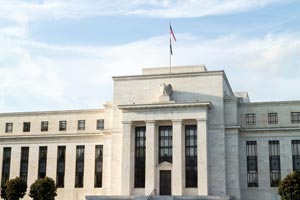The Fed meeting today (Wednesday) delivered another humdrum statement soaked in predictable Fedspeak.
The decision? The U.S. Federal Reserve's Federal Open Market Committee is considering rate hikes on a meeting-by-meeting basis. Something we already knew.
 How many more times will we read some variation of this?
How many more times will we read some variation of this?
"To support continued progress toward maximum employment and price stability, the Committee today reaffirmed its view that the current 0 to 1/4 percent target range for the federal funds rate remains appropriate. In determining how long to maintain this target range, the Committee will assess progress - both realized and expected - toward its objectives of maximum employment and 2 percent inflation," today's FOMC statement read.
In these Fed meetings, the FOMC is wary of spooking the markets. With every statement released, markets are forced to digest a steady diet of vague pronouncements about the future of rate hikes and ambiguous assertions about the health of the U.S. economy.
What markets didn't see in the statement from the Fed meeting today - especially now as the Fed begins to wind down its easy money policies and can thus claim that it's pursuing a "responsible" monetary policy - is just what damage the FOMC has already done to the macroeconomic picture.
The Fed's easy money policy has been a ploy to keep banks afloat. The Fed is terrified of any panics in the financial system.
"The one thing that central banks the world over don't want to have happen is a default. They don't want a run on the banks," Money Morning Chief Investment Strategist Keith Fitz-Gerald said. "So, they are doing everything they can to maintain the illusion of prosperity. And that means prop banks up, save them...whatever."
Three rounds of QE were supposed to get the economy going. But those reserves banks built up on the backs of Fed funds created out of thin air weren't loaned out. Banks arbitraged QE instead. These profits helped them stay afloat.
All while allowing the same bad practices to continue unabated, and to, ultimately, pave the way for a future collapse in global financial markets...
What the Fed Meeting Today Is Leaving Out About the Global Financial System
"The issue is that the modern banking system is based on what they call hypothecated assets - a fractional reserve system," Fitz-Gerald said. "You only need to have one dollar on tap for every eight, nine dollars in the system. So you take that dollar and you keep part of it and you loan part of it. And the next bank keeps part of it and loans part of it - usually eight or nine times."
[epom key="ddec3ef33420ef7c9964a4695c349764" redirect="" sourceid="" imported="false"]
The problem will become apparent when the easy money game is up. All it takes is one bank failure to ripple through the whole financial system.
"Somebody's going to be looking for that actual dollar because they're going to want to perfect their collateral and that potentially starts what they call a 'cascading default' series," Fitz-Gerald said. "So, this bank has its margin call, can't meet it, fails. That bank has debt with that bank which now gets the same margin call, which fails. This creditor has a run upstream until they find the dollar."
"Cascading default" is absent from the statement released after the Fed meeting today. What's also absent from the Fed meeting today was any indication that the Fed is aware of its role in bringing on a future collapse. Not that it was to be expected.
In fact, the Fed meeting today will be painted as one of the last few meetings of the zero interest rate policy era. It will be as if the country's fiscal house has been righted, and the clean up from the last global financial crisis is nearing an end.
But in reality, the seeds of the next global financial crisis have already been sowed. And Europe and Japan are all too willing to keep the central bank game going through their own QE measures.
"It's getting worse. By every metric imaginable," Fitz-Gerald said. "The banks are more concentrated, there are more derivatives, there's more risk, there's more leverage, and the concentration of risk is even more extreme than it was before 2007. The government wants you to believe that they've cleaned this mess up. Not even remotely close."
The U.S. is setting up for an imminent $100 trillion collapse... At least, that's what the post-9/11 CIA operation "Project Prophecy" shows us. This operation helped foil a 2006 London terrorist attack and warned of the 2008 recession well before the fall of Lehman Brothers. Now it has spotted signs that a 25-year Great Depression is in our future, and you'll want to do all you can to preserve your wealth before the storm comes. CIA economist Jim Rickards tells you how to here...
Jim Bach is an Associate Editor at Money Morning. You can follow him on Twitter @JimBach22.


